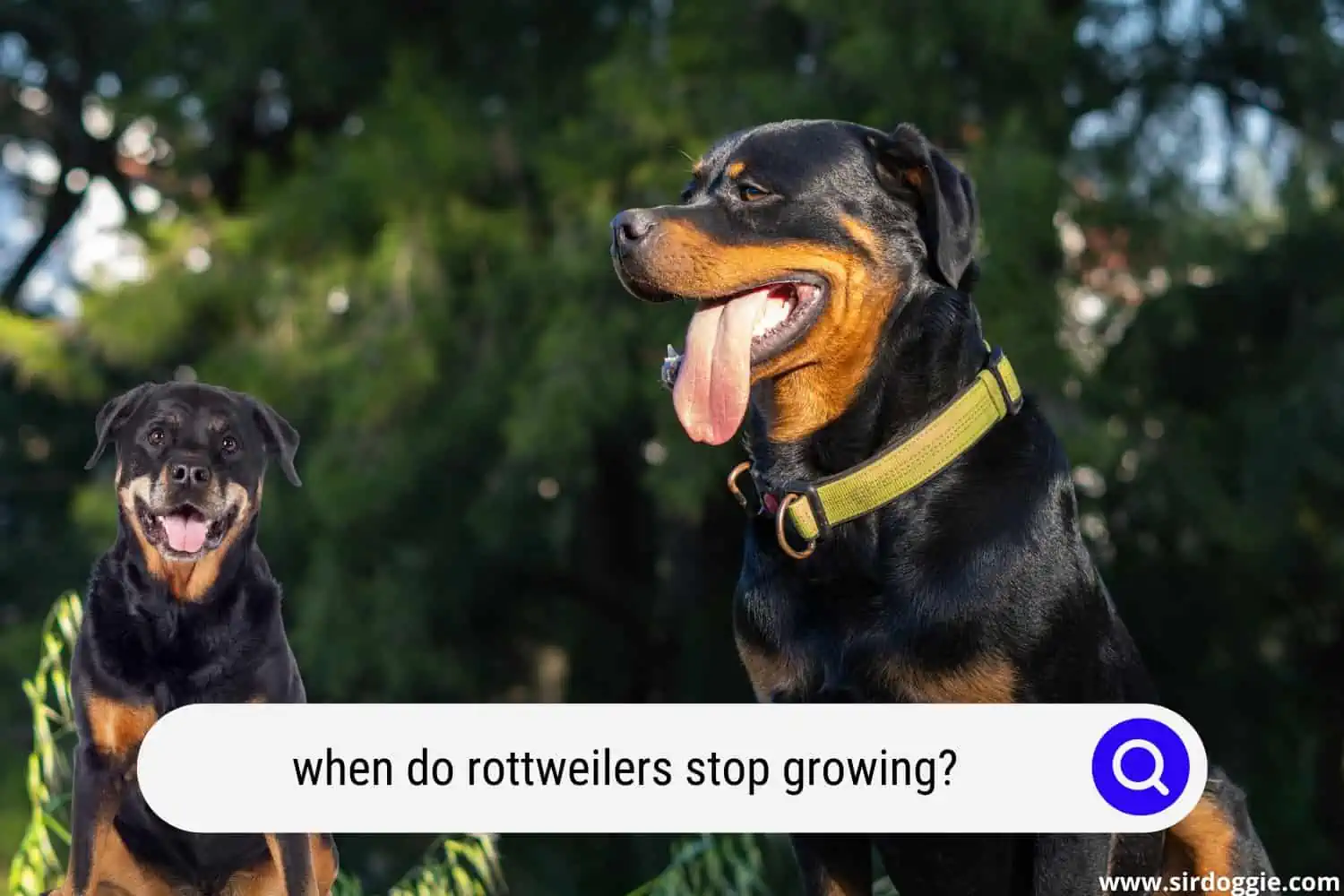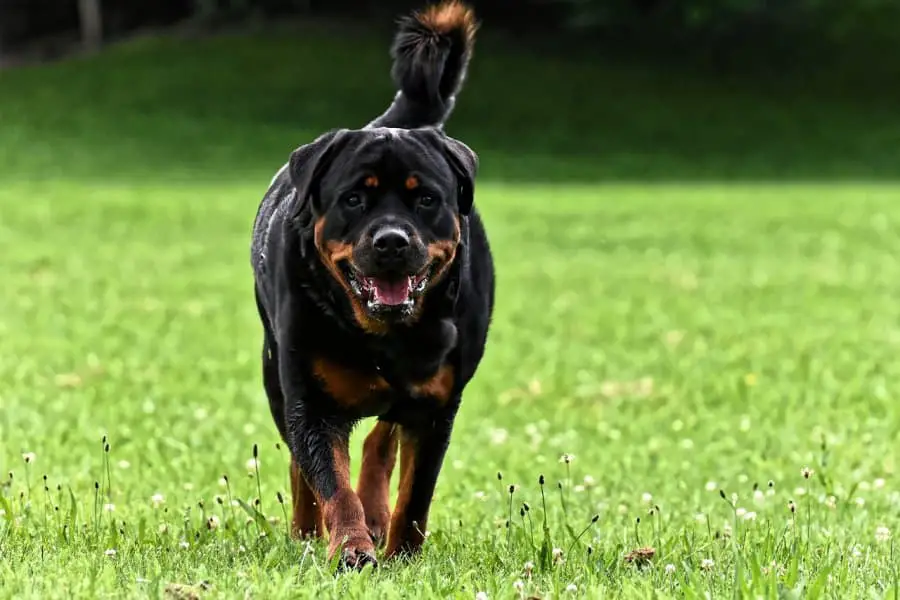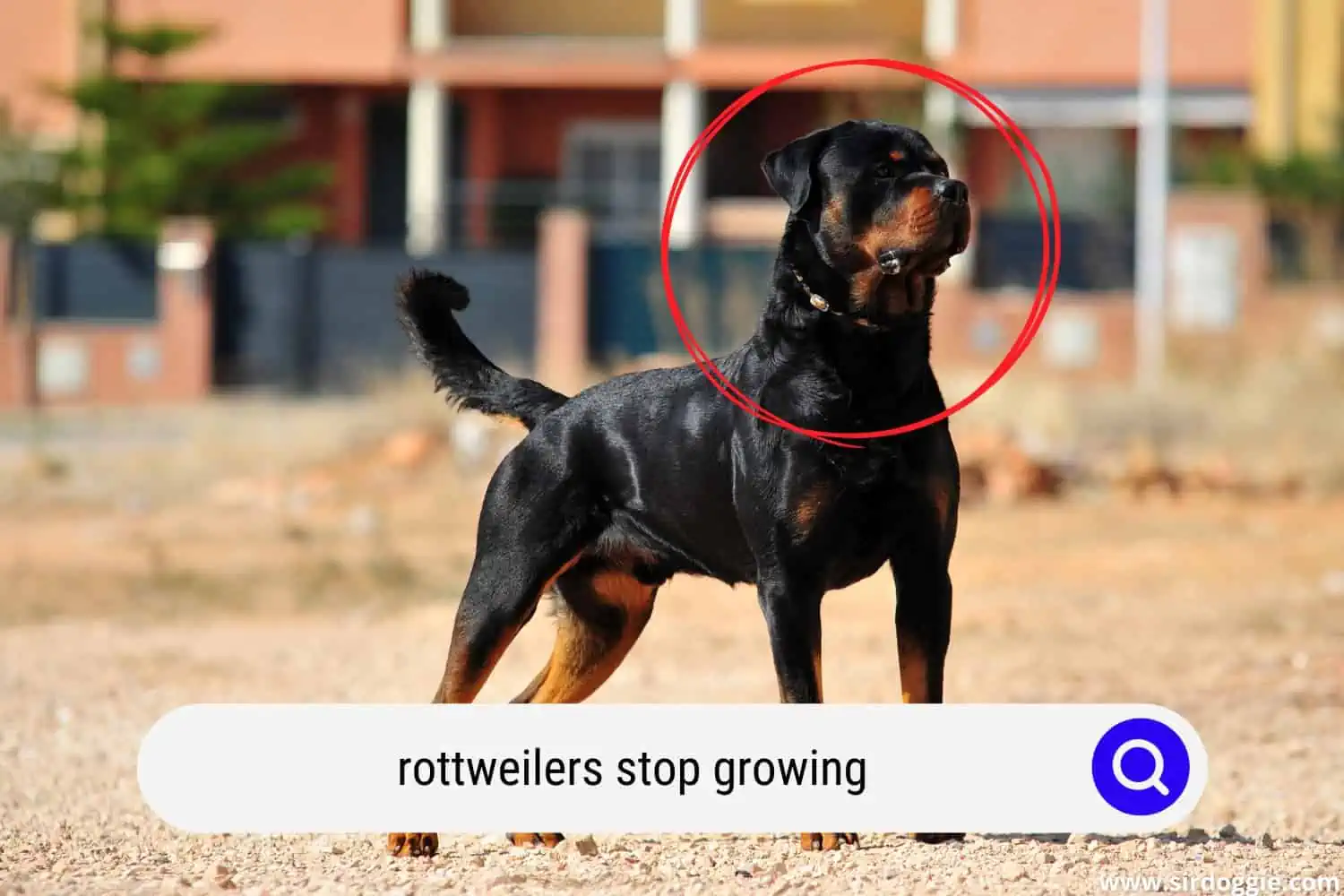When Do Rottweilers Stop Growing? [ANSWERED]
Rottweilers stop growing at around 18 to 24 months old, though it can differ in some cases. The dogs usually reach their adult height after a year, but they will keep gaining weight after that. Planning for that time can help when it comes to choosing food and toys for the dog.

Rottweilers can make great dogs, but they can get pretty big. As with any dog, it can help to know when a Rottweiler reaches their adult size.
That way, you can better plan for their daily care and activities.
Rottweilers are big dogs, and they can be intimidating if you’ve never been around one.
If you get a young Rottweiler, you can’t expect it to stay that size. Keep reading to learn about when Rottweilers stop growing.
Related Reading: Are Rottweilers Good With Cats? [ANSWERED]
Rottweiler Height
The maximum height for most Rottweilers is 22 to 27 inches (around 55 to 68 cm) depending on the gender.
Females can grow to be 22 to 25 inches (around 55 to 63 cm) tall, and males can reach 24 to 27 inches (around 60 to 68 cm) in height.
It will take Rottweilers anywhere from a year and a half to two years to reach their full height.
The growth phase is pretty consistent after the first couple of months. Many young Rottweiler puppies grow quickly in the first few months.
After they hit about six or seven months old, they won’t grow as fast. However, they’re still nowhere near their final height.
Rottweilers can continue to grow for years after they reach adulthood.
But puppyhood is the time when they will grow the most and the fastest, so make sure you plan for that when getting a Rottweiler puppy.

Rottweiler Weight
While Rottweilers can reach their maximum height in a year and a half, they won’t reach their maximum weight for another few months. After about two years or longer, you can expect your Rottweiler to weigh 80 to 135 pounds (around 36 to 61 kg).
Like when it comes to height, males weigh more than females. A full-grown female can weigh about 80 to 100 pounds (around 36 to 45 kg).
But an adult male Rottweiler can be about 95 to 135 pounds (around 43 to 61 kg).
So even if your dog is the height of a full-grown Rottweiler, they may still have more pounds to gain.
After they reach their full height, they’ll continue to get their big muscles and broad shoulders. They can develop strong muscles all over their body, which can make them scary for some people.
However, they can be very caring and loyal.
Male vs. Female Growth Rates
While males and females can be quite different in size, all Rottweilers reach their full size after about two to three years.
Because of this, they have different growth rates. Since females don’t need to get as big as males, they grow more slowly.
They can still be just as muscular and strong, but they won’t be as tall or heavy. Many Rottweilers of both genders reach their full size after a couple of years.
But some dogs may take an extra year, and that is perfectly normal. It can actually be much safer for big dogs like Rottweilers to grow slowly so that they don’t have problems during their growth.
Risks During Growth
While many Rottweilers can maintain their health while they grow, they do have risks. If you’re considering getting a Rottweiler puppy, you should understand these risks and their signs.
That way, you can get your dog to the vet for help.
You can then talk to the vet about how to reduce risks for your dog. The vet may recommend different foods or other products to help keep your dog in good shape.
Here are a few risks to know about.
Bone and Joint Problems
Rottweilers already face an increased risk for bone and joint problems. If their body experiences a lot of excess stress while they grow, it can make the problem even worse. Some specific bone and joint issues you may find include:
- Elbow Dysplasia
- Hip Dysplasia
- Osteochondrosis of the ankle, spine, or shoulder
If you notice your Rottweiler isn’t moving as easily or looking to be in pain, take them to the vet. It may be nothing, but you may discover that your dog has a health condition.
Then, you can treat the condition and ensure your dog grows to be happy and healthy.
Weight Gain
Another big problem growing Rottweilers can have is excessive weight gain. While they do need to gain weight as they grow, they shouldn’t become overweight or obese.
Excess weight can go hand in hand with joint problems because it will put more pressure on your dog’s joints.
You can check your dog’s weight each month to make sure they’re on track. Most growing Rottweilers should gain about 10 to 15 pounds (around 4.5 to 6 kg) per month.
If your dog gains significantly more than that, you can take them to the vet.
You can also give your dog daily walks or exercise at home. That way, your dog can burn some calories and get the exercise they need to protect their growing body.
Related Reading: The Red Rottweiler, Do They Actually Exist?
How Much to Feed Your Rottweiler
As your doggie grows, you will need to adjust how much food you give your Rottweiler. Puppies, surprisingly, need to eat more often throughout the day. But older dogs will need more food and nutrients.
No matter your dog’s age, you should feed them at specific times. When they finish, move their bowl out of reach so that they aren’t tempted by it.
And if your Rottweiler lives with cats or other animals, make sure they are stealing other food or having their food stolen.
Here’s how you should feed your Rottweiler at different ages.
For Puppies
Puppies less than four months old should have about two to three pounds (around 1 kg) of food per day. Look for foods with natural ingredients specifically for puppies.
Then, you can feed your dog about three to four times each day.
As they reach four months old, they can stay on the food for puppies, and you may not need to feed your dog as often. They might be able to eat closer to three times per day or sometimes twice a day.
You can give your dog some fruits and vegetables as a treat, but make sure you don’t give them too much.
If you do give too many treats, you could cause your Rottweiler to become overweight.
For Growing Rotties
As your Rottweiler keeps growing, you can start feeding them even more food. When your dog hits about 60 pounds (around 27 kg), you can feed them seven to eight cups of food each day.
Once they top 80 pounds (around 36 kg), you can add another third cup over 8 2/3 cups.
This is also when you should start transitioning your dog to adult food. Don’t switch all at once because that can be hard on your dog. Instead, slowly switch the food over one week.
For the first two days, give your dog three parts of old food and one part of new food. On days three and four, mix the two foods in equal amounts.
Then, give your dog one part of the old food and three parts of the new food. On the last day, you can start using the new food.
For Adults
It may look like your dog is done growing, but after a year and a half, they can still get bigger. At this point, you can start feeding your dog twice a day, and you can use adult food.
Your dog could be eating anywhere from seven to nine pounds of food each day.
However, talk to the vet about how much to give your dog. If your dog is showing signs of obesity, you may want to cut back on food.
That way, your dog can still get the nutrients they need without gaining too much weight.

Final Thoughts
Rottweilers stop growing at anywhere from a year and a half old to sometimes three years old. This will vary on various factors, especially if your Rottweiler is a mixed breed.
It all depends on the type of growth you’re thinking about and your specific Rottweiler.
Make sure you give your dog some exercise and the right food to support them as they grow.

Family Dog Expert Author
Hi there! I’m Stuart, a devoted dog lover and family dog expert with over a decade of experience working with our furry companions. My passion for dogs drives me to share my knowledge and expertise, helping families build strong, loving bonds with their four-legged friends. When I’m not writing for SirDoggie, you’ll find me hiking, playing with my beautiful dog, or studying music.